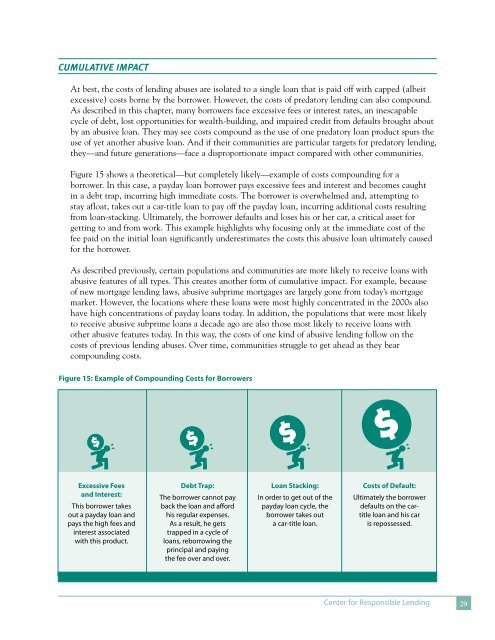Create successful ePaper yourself
Turn your PDF publications into a flip-book with our unique Google optimized e-Paper software.
<strong>Cumulative</strong> Impact<br />
At best, the costs <strong>of</strong> lending abuses are isolated to a single loan that is paid <strong>of</strong>f with capped (albeit<br />
excessive) costs borne by the borrower. However, the costs <strong>of</strong> predatory lending can also compound.<br />
As described in this chapter, many borrowers face excessive fees or interest rates, an inescapable<br />
cycle <strong>of</strong> debt, lost opportunities for wealth-building, and impaired credit from defaults brought about<br />
by an abusive loan. <strong>The</strong>y may see costs compound as the use <strong>of</strong> one predatory loan product spurs the<br />
use <strong>of</strong> yet another abusive loan. And if their communities are particular targets for predatory lending,<br />
they—and future generations—face a disproportionate impact compared with other communities.<br />
Figure 15 shows a theoretical—but completely likely—example <strong>of</strong> costs compounding for a<br />
borrower. In this case, a payday loan borrower pays excessive fees and interest and becomes caught<br />
in a debt trap, incurring high immediate costs. <strong>The</strong> borrower is overwhelmed and, attempting to<br />
stay afloat, takes out a car-title loan to pay <strong>of</strong>f the payday loan, incurring additional costs resulting<br />
from loan-stacking. Ultimately, the borrower defaults and loses his or her car, a critical asset for<br />
getting to and from work. This example highlights why focusing only at the immediate cost <strong>of</strong> the<br />
fee paid on the initial loan significantly underestimates the costs this abusive loan ultimately caused<br />
for the borrower.<br />
As described previously, certain populations and communities are more likely to receive loans with<br />
abusive features <strong>of</strong> all types. This creates another form <strong>of</strong> cumulative impact. For example, because<br />
<strong>of</strong> new mortgage lending laws, abusive subprime mortgages are largely gone from today’s mortgage<br />
market. However, the locations where these loans were most highly concentrated in the 2000s also<br />
have high concentrations <strong>of</strong> payday loans today. In addition, the populations that were most likely<br />
to receive abusive subprime loans a decade ago are also those most likely to receive loans with<br />
other abusive features today. In this way, the costs <strong>of</strong> one kind <strong>of</strong> abusive lending follow on the<br />
costs <strong>of</strong> previous lending abuses. Over time, communities struggle to get ahead as they bear<br />
compounding costs.<br />
Figure 15: Example <strong>of</strong> Compounding <strong>Costs</strong> for Borrowers<br />
$<br />
$<br />
$<br />
$<br />
Excessive Fees<br />
and Interest:<br />
This borrower takes<br />
out a payday loan and<br />
pays the high fees and<br />
interest associated<br />
with this product.<br />
Debt Trap:<br />
<strong>The</strong> borrower cannot pay<br />
back the loan and afford<br />
his regular expenses.<br />
As a result, he gets<br />
trapped in a cycle <strong>of</strong><br />
loans, reborrowing the<br />
principal and paying<br />
the fee over and over.<br />
Loan Stacking:<br />
In order to get out <strong>of</strong> the<br />
payday loan cycle, the<br />
borrower takes out<br />
a car-title loan.<br />
<strong>Costs</strong> <strong>of</strong> Default:<br />
Ultimately the borrower<br />
defaults on the cartitle<br />
loan and his car<br />
is repossessed.<br />
Center for Responsible Lending 29


